Sky wanted its new film studio in Elstree built in double-quick time to help meet movie makers seemingly insatiable demand for space. How did the contractor get on?
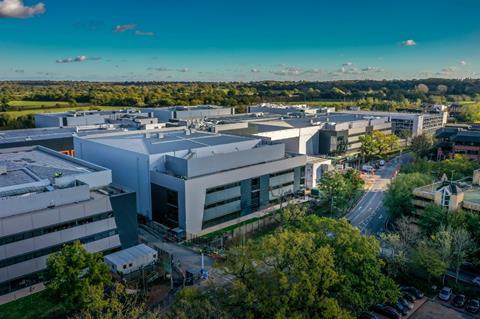
Hollywood eat your heart out. The place to make movies is no longer sunshine-blessed Los Angeles but drizzly old England. According to Lambert Smith Hampton, a property consultancy specialising in film and TV studios, film and TV production was the fastest growing sector of the UK economy in the five years to 2019.
The pandemic temporarily stopped film production in 2020 but this has since taken off again, a trend that is fueling an insatiable demand for new production facilities. In 2021 there were 4,200,000ft2 of dedicated film and TV studios in the UK with another 1,200,000ft2 housed in repurposed space.
There are 5,300,000ft2 of film and TV studio space in Los Angeles which means that, with 1,500,000ft2 of oven-ready production space in the pipeline, the UK, nicknamed “Brollywood”, is shortly set to trounce Hollywood as the place to make films.
The boom is being driven by a combination of growth in streaming services – Netflix spends £12.5bn on new programming globally each year alone – and generous tax breaks for film and TV production in the UK. The growth in new facilities is divided between expansion of traditional locations including Pinewood, Elstree and Shepperton and new-build studios such as a 250,000ft2 studio under construction in Dagenham and Sunset Studios in Broxbourne, which recently received planning and is set to become the UK’s largest studio.
>> Also read: Construction seizes the chance to make it in the movies
Sunset Studios will be built in a part of Hertfordshire that is fast becoming the British Hollywood. The county is already home to Warner Brothers Studios at Leavesden and Elstree Studios.
The latter was established in the 1920s and recently opened two new sound stages, the first in 15 years. Just three miles away, contractor BAM is putting the finishing touches to the brand new Sky Studios Elstree, which will include 260,000ft2 of studio space on a 27.5 acre site, making it substantially bigger than its long-established neighbour.
The new studios will include 12 sound stages ranging in size from 10,000 to 40,000ft2, where filming takes place. These are housed in six buildings and include office space for production staff too. There are also two large production support buildings for set production and costumes.
The sound stages and production buildings are essentially large, business park-type sheds, the main difference is the sound stages feature metre-thick walls which are stuffed with insulation for acoustic reasons and a roof-level technical grid for rigging and a huge number of electrical sockets. There is also a 1,000 space multi-storey car park and reception building incorporating an event space.
The site includes everything needed to produce a ready-to-go feature film. Sky is owned by broadcasting giant Comcast. The studios will produce feature films and box sets for streaming. Other film production companies will be able to hire space too.
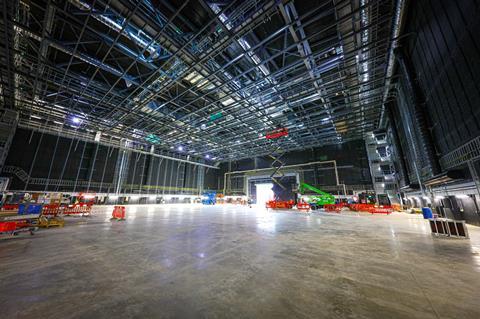
Six of the sound stages and the two production buildings have already been taken over by Sky and are up and running. BAM is still working on the other six stages and associated office space.
In an ideal world BAM would have handed over the scheme when the whole complex was complete, but supply delays, Covid, Brexit and even weather has impacted on the programme. As dates slipped, all parties worked in collaboration to agree next steps and a revised schedule that would allow production to start whilst BAM finished off other sections of the site.
The job was procured as a two-stage tender with BAM winning the main contract in July 2020. All the pre-contract work had to be done remotely because of the covid lockdown. “We couldn’t physically meet anyone until after we got appointed,” Brian Connor, project director for BAM says.
BAM spent the next six months getting ready for the job, with the contract signed in December 2020. Developer Legal & General, which owns the site and leases it to Sky, engaged its own contractor to demolish the existing buildings on the site and start preparing the ground, ostensibly to save time.
Preparation also included getting consent to move an overhead power line and water main running through the site and to build a new road junction. Connor says these consents were very slow to come through.
“There were a few things stacking up at the front end, where they knew they were having delays, which was putting the programme out,” he explains. “At the same time Sky was in negotiations for potential movie productions including when they might need the space.”
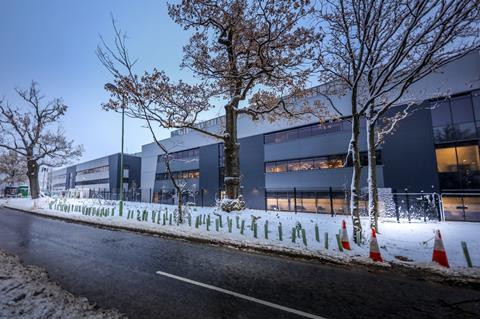
To help mitigate the impact of these delays Sky and BAM agreed a schedule of sectional handovers, that is to say handing over individual buildings as these completed. Inevitably, this complicated the job. “Delays to the build schedule means there has been more of an overlap between our works and movie production,” Connor says.
“There has been provision for early access, which usually means an IT specialist coming in and installing the data networks,” Connor explains. “However, early access for productions has meant building large film sets, which we have had to work around.
Challenges include the different priorities of construction and movie production. For example, productions need to keep details of filming under wraps so that no intellectual property gets out to the public domain, so Sky asked workers to not take any non-task specific photos.

But the need to complete facilities for Sky while simultaneously building the infrastructure serving the site has impacted the building schedule. The simplicity of the buildings above ground belies the complexity of what lies beneath.
“What is difficult to appreciate now is the sheer amount of infrastructure,” Connor says. “The roads around the site are absolutely full of infrastructure – massive drains that you can drive a car through, power cabling including lots of doubling up to diversify supply, water mains, data cabling and spare ducts for future capacity.”
The site is located on a flood plain, so a stream had to be diverted around the site and three retention ponds dug in one corner of the site. Underground retention tanks have also been installed to increase flood water capacity.
“You look at the 3D BIM images and all this literally doesn’t fit,” says Paul Avery, BAM’s construction manager on the job. BAM had to undertake a massive services co-ordination exercise, using the information from the different consultants on the job, to get it all to fit. Tweaks included dropping the water services, which must be at least 750mm below ground, down to one metre to create more room for the ducts.
The sectional building handover meant BAM was simultaneously carrying out jobs that would normally be done sequentially. This included doing site preparation in some areas, putting in foundations next to structural steelwork erection and getting services into buildings whilst the cladding was going on.
This also created the logistical headache of maintaining safe routes for 1,000 workers and vehicles through a site which was changing daily. At one point the site entrance had to be temporarily moved, so this cut through the middle of a half-finished building.
This was all happening at a difficult time for construction. “We have been in the eye of the storm with covid, Brexit, the war in Ukraine and material availability and price increases,” says Connor. “The location hasn’t helped either as we are on the edge of London but not in London, so trying to get 1,000 people to come here has been a challenge.”
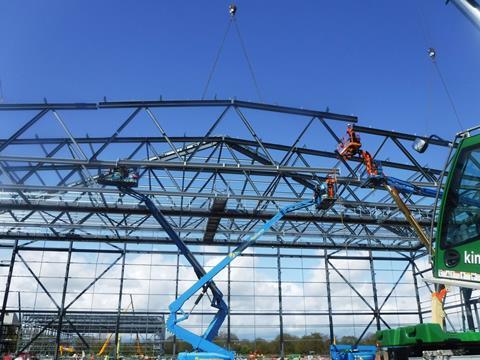
Fortunately steelwork and cladding specialists Severfield and CA Roofing Services had bought materials in advance. But M&E specialist Lorne Stewart took the impact of material price increases, including on the 5.5km of heavy duty high voltage copper cabling needed for the job.
Connor says L&G stepped in to help mitigate the impacts of these price increases – as did others on the project. “Everyone took a bit of pain,” Connor says. O’Keefe, who did the concrete hardstanding and trenches, went into voluntary administration but they were kept going on a day-rate basis.
All these challenges had the potential to trigger a massive falling out. This has been complicated by BAM being contracted to Legal & General but also needing to meet the pre-agreed timelines with L&G’s tenant Sky so they can start operating the studios.
Connor admits it has been difficult at times, but everyone has remained happy. “Relationships remain very strong – that is what has carried us through as it could have got really messy.” Sky now has its first production onsite.
What would have been the ideal way to tackle such a complex job? Firstly, for the main contractor to have responsibility for the enabling works.
L&G appointed Kane Group to prepare the ground, which included moving 56,000m3 of soil before the main contract was signed. The rain started coming down after the topsoil had been removed, which turned the underlying London clay into an unmanageable, sticky quagmire, extending this job three months into BAM’s contract period.
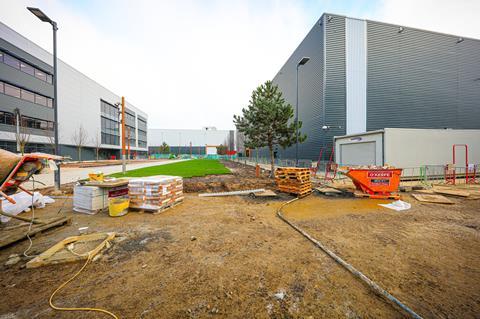
Connor says ideally all the infrastructure work would have been done next, followed by the hard-standing between the buildings and the slabs for the buildings followed by the actual buildings. Doing it this way would not have been any quicker but it would have been more efficient – which would have saved money.
L&G has applied for permission to build a second phase of studios next door to the existing site. This site, which extends to 38 acres, will add another 10 sound stages with 210,000ft2 of filming space, taking the whole site up to 470,000ft2.
The method statement accompanying the planning application proposes to build the second phase this way – assuming it gets through planning in the face of over 1,700 objections. Either way, there will be plenty of opportunities for the industry to further hone its skills and help make the UK the film studio capital of the world.
Project team
Developer Legal & General
Tenant Sky
Architect UMC Architects
Cost consultant Potter Raper
M&E engineer Hoare Lea
Structural engineer Fairhurst
Main contractor BAM
Structural steelwork Severfield
M&E installation Lorne Stewart
Cladding CA Roofing Services




























No comments yet